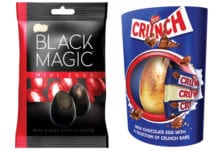AS chocolate fans of all ages around the UK got ready to crack open Easter eggs and bunnies last month, leading research organisation Mintel released figures on the chocolate confectionery market in the UK showing that nearly one in six (16%) Brits, roughly 8m people, eat chocolate every day. A similar amount (17%) do so four to six times a week.
Only a tiny minority (5%) of Brits never eat chocolate. Mintel says the findings show that chocolate remains one of Britain’s favourite treats.

A daily chocolate fix seems to be particularly popular among young consumers, those aged 25-34, with almost a quarter (22%) of them eating chocolate daily, compared to that 16% overall average that covers all age groups.
Scotland is said to have a sweet tooth but maybe not the very sweetest among Britons.
Mintel found that Londoners are significantly more likely to consume chocolate every day, with up to 26% of consumers living in London doing so as compared to 17% of those living in Scotland and the north of England.
Some 12% of those living in south-east England and East Anglia are daily chocolate users, it’s 16% in south-west England and Wales, 15% in the East and West Midlands of England, 15% in the English north-west, and 11% in Yorkshire and Humberside.
Richard Ford, senior food and drink analyst at the research firm, explained: “From the Aztecs to Willie Wonka, in both fact and fiction, cocoa and chocolate have held a special place in people’s hearts throughout the centuries.
“That’s no less so today – demonstrated by the fact that just a small minority of Brits say they never eat chocolate. Its status as a personal treat remains an ingrained part of consumers’ diets, despite the recent focus on the role of foods high in fat and sugar in the nation’s weight gain.”
Weight might be a concern, but it could also be the case that increasing numbers of people in the third world are benefiting from Britain’s love of chocolate.
Mintel’s research shows 120% growth in the number of new chocolate products launched carrying an ethical claim, such as Fairtrade certification, between 2012 and 2013. Overall, out of all new chocolate products launched, the share of launches carrying ethical claims rocketed to 17% in 2013 from just 4% in 2010.
The survey says chocolate purchasing habits also show British consumers’ generosity and sensitivity as gift buyers.
When buying chocolate as a gift the recipient’s tastes and preferences guide the decisions of 54% of consumers.
However, it looks as if the ladies might just be a little more considerate. Some 58% of women are more likely to keep the recipient’s tastes in mind compared to 49% of men.
If women have a reputation for being more enthusiastic about chocolate it might not be entirely deserved.
In terms of overall frequency of chocolate consumption, there is little difference between men and women (16% of men versus 15% of women).
However, there are gender differences on preferences for the various styles of block chocolate. Women are more likely to have eaten flavoured block chocolate (50% of women compared to 44% of men). But men are more likely to have eaten standard white block chocolate (32% of men vs 27% of women).
l See still more info on chocolate in our Chocolate Review on page 104.













